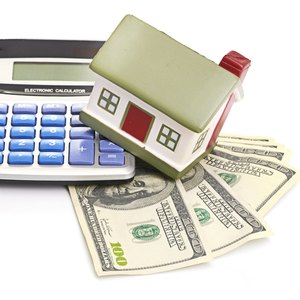
Interest is the major part of the price you pay for a mortgage. If you calculate interest for every $1,000 you borrow, rather than on the entire loan, you can easily see how reducing your interest rate can save you on a mortgage. Banks, real estate professional associations and Internet sites devoted to financial or mortgage information offer calculators to help you calculate the interest per every $1,000 you borrow.
Tips
You can easily calculate how much interest you're paying for every $1,000 you borrow by using an online mortgage calculator or amortization table. This calculation will help you compare interest rates on a smaller amount instead of over the life of a longer-term loan to help you shop for the best interest rate and choose a loan term that best fits your budget.
Calculate by Using $1,000
Visit the National Association of Realtors at Realtor.com for an online calculator that lets you enter $1,000 as the loan amount. Hover over "Mortgage" on the top bar and select "Home Finance." On the "Home Finance" page, click "Mortgage Calculator" under "Tools and Calculators."
Enter 1,000 in the "Loan Amount" space, since you are calculating the interest for every $1,000. Select the interest rate and the length of the mortgage in years.
Click the “Calculate” button on calculator. Under "Your Amortization Schedule," choose the “Monthly” tab, then scroll down to see the total interest on the loan. For example, for a loan at 5 7/8 percent interest for 30 years, the Realtor.com calculator shows the total interest per $1,000 borrowed as $1,129.
Calculate Using Loan Amount
Find a calculator, such as one from Mortgage Calculator at mortgagecalculator.org, that reports total principal and interest payments per $1,000. From the Mortgage Calculator home page, scroll to the bottom and select the "More Calculators" link, which will direct you to the Free Online Mortgage Calculators page. Choose the link for "Monthly Interest+Principal Cost Per Thousand."
Type the amount you plan to borrow, rather than $1,000, in the "Amount" field. Express the interest rate as a decimal rather than a mixed-fraction. Divide the denominator into the numerator to convert the fraction. For example,enter an interest rate of 5 7/8 percent into Mortgage Calculator as 5.875 percent. Input the length of the loan in years. Unless you know or are curious about the effect of loan origination fees, points and closing costs, use “0" for these items.
Click “Let Me Print That Form in PDF” for a full report, or click "Calculate" and scroll to the top of the Mortgage Calculator screen to view the results. Find the "Lifetime Payment per Thousand" in those results. For example, if your mortgage has a 5.875 percent interest rate for 30 years, your total mortgage payment per $1,000 is $2,129.54.
Subtract $1,000 from the "Lifetime Payment per Thousand" as indicated by Mortgage Calculator. For a 30-year loan and an interest rate of 5.875 percent, $2,129.54 minus $1,000 results in a mortgage cost of $1,129.54 per $1,000 borrowed.
Mortgage Payment Table
Locate a mortgage table that tells you the monthly payments per every $1,000. For example, USA.gov’s Federal Citizen Information Center publishes a guide called “How to Buy a Home With a Low Down Payment” that includes such a table.
Look on the table for your annual interest rate and the length of your loan. The figure listed at the intersection of that interest-rate row and number-of-years column is the monthly payment for each $1,000 you borrow. For example, on a 30-year loan at 6 percent interest, the table shows that you would pay $6 per month per $1,000 you borrow.
Multiply the monthly payment as shown on the table by the number of months on your loan. If your mortgage lasts 30 years, multiply the payment shown by the table by 360 months. On a 30-year loan at 6 percent interest, use $6 for the monthly mortgage payment per $1,000 times 360 to arrive at total principal and interest paid of $2,160 per every $1,000 you borrow.
Subtract $1,000 from the total principal and interest payments for the loan period to find the total interest you’ll pay for each $1,000 you borrow. For a 30-year loan at 6 percent interest, $2,160 in total principal and interest payments minus $1,000 equals $1,160 in interest for every $1,000.
Using an Amortization Table
If you use an amortization table that shows principal and interest per $1, multiply the amount shown for the interest rate and length of the loan by 1,000. For example, you'll pay $0.08883 -- or approximately 9 cents -- per dollar on a 30-year loan at 8 percent interest. This translates to an annual payment of $88.83 per $1,000 borrowed; multiply 30 payments (for 30 years) by $88.83 and subtract $1,000 for a total cost of $1,664.90 per $1,000 borrowed.
Factoring in One-Time Closing Costs
Closing costs include brokers' commissions, fees and appraisal costs. You'll incur these one time, unless your lender lets you roll them into the loan. If you include these in your loan, you'll pay more in interest, which will increase your monthly payment.
Mortgage Payment Calculator
References
- Realtor.com: Home Finance: Financial Calculators
- HSH.com: Monthly Payments per $1,000 & Total Cost (Principal and Interest Combined)
- U.S. Department of Housing and Urban Development. "Federal Housing Administration." Accessed Mar. 9, 2020.
- Consumer Financial Protection Bureau (CFPB). "What Is Private Mortgage Insurance?" Accessed Mar. 9, 2020.
- Consumer Financial Protection Bureau (CFPB). "How Do Mortgage Lenders Calculate Monthly Payments?" Accessed Mar. 9, 2020.
- Consumer Financial Protection Bureau (CFPB). "How Does Paying Down a Mortgage Work?" Accessed Mar. 9, 2020.
- Consumer Financial Protection Bureau (CFPB). "Seven Factors That Determine Your Mortgage Interest Rate." Accessed Mar. 9, 2020.
- Rocket Mortgage. "Property Taxes: What They Are and How They’re Calculated." Accessed Mar. 9, 2020.
- Travelers. "What's the Difference Between Homeowners Insurance and Mortgage Insurance?" Accessed Mar. 9, 2020.
- Consumer Financial Protection Bureau (CFPB). "What Is a Prepayment Penalty?" Accessed Mar. 9, 2020.
- Internal Revenue Service (IRS). "Publication 936 (2019), Home Mortgage Interest Deduction." Accessed Mar. 9, 2020.
- Consumer Financial Protection Bureau (CFPB). "TILA-RESPA Integrated Disclosures." Accessed Mar. 9, 2020.
Tips
- Closing costs include brokers' commissions, fees and appraisal costs. You'll incur these one time, unless your lender lets you roll them into the loan. If you include these in your loan, you'll pay more in interest, which will increase your monthly payment.
- If you use an amortization table that shows principal and interest per $1, multiply the amount shown for the interest rate and length of the loan by 1,000. For example, you'll pay $0.08883 -- or approximately 9 cents -- per dollar on a 30-year loan at 8 percent interest. This translates to an annual payment of $88.83 per $1,000 borrowed; multiply 30 payments (for 30 years) by $88.83 and subtract $1,000 for a total cost of $1,664.90 per $1,000 borrowed.
Warnings
- Tables and online calculators might give you different total mortgage costs, depending on how many digits are rounded.
Writer Bio
Christopher Raines enjoys sharing his knowledge of business, financial matters and the law. He earned his business administration and law degrees from the University of North Carolina at Chapel Hill. As a lawyer since August 1996, Raines has handled cases involving business, consumer and other areas of the law.

